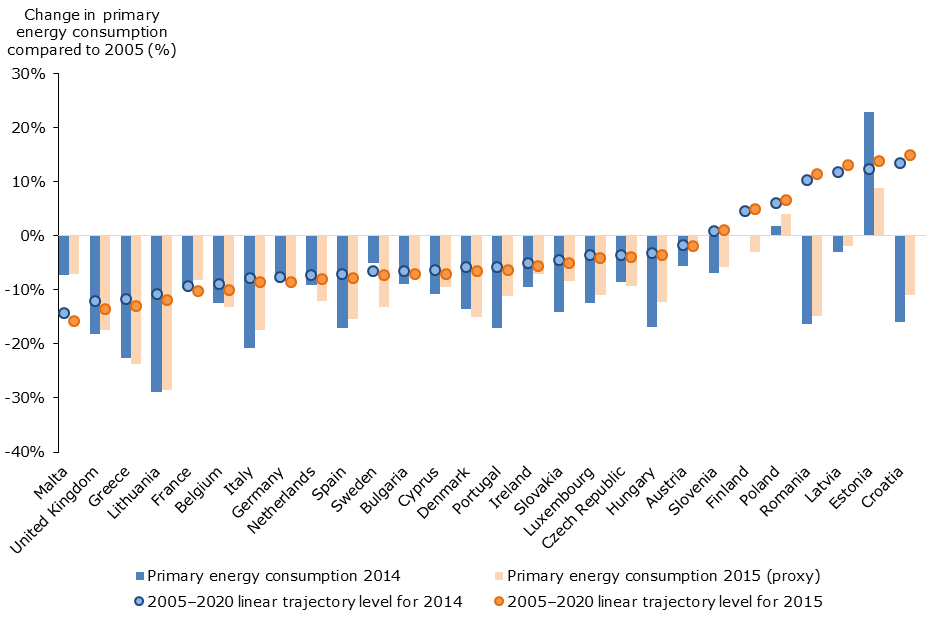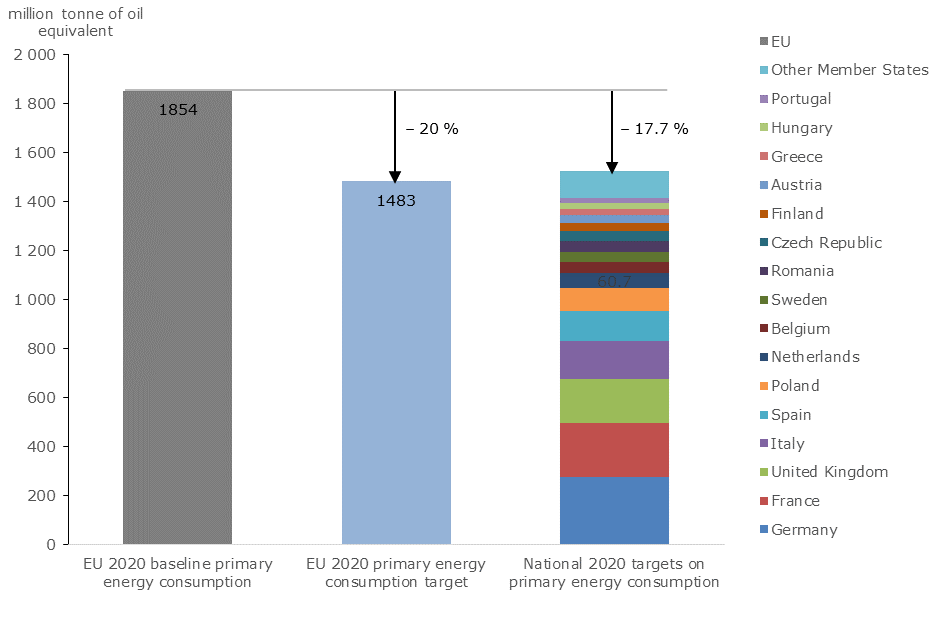7.1 Progress towards national primary energy consumption targets
In order to achieve the European Union’s (EU’s) objective of reducing its energy consumption by 20 % compared with the baseline scenario by 2020, the Energy Efficiency Directive (EED) requires Member States to set their own national non-binding targets for either primary or final energy consumption for 2020 (EU, 2012). For primary energy consumption, Member States have set targets that range from a 24 % reduction (Malta) to a 22 % increase (Croatia) compared with 2005 levels. A total of 21 Member States have targets to decrease primary energy consumption, while the 2020 primary energy consumption targets of seven Member States (Croatia, Estonia, Finland, Latvia, Poland, Romania and Slovenia) are higher than 2005 levels [1]. Member States can also revise their targets upwards or downwards at any point in time.
As neither Member States nor EU legislation set any indicative trajectory to monitor the progress of Member States towards their national 2020 targets, this analysis tracks progress to energy efficiency targets by considering, for each Member State, an indicative linear trajectory between 2005 primary energy consumption levels and 2020 targets, and by comparing historic levels of primary energy consumption with this linear trajectory. A country is considered to be on track towards meeting its 2020 target if its primary energy consumption is below its linear trajectory. Conversely, a country with primary energy consumption levels above its linear trajectory needs to reduce or limit its energy consumption at a faster pace, in order to meet its 2020 objective.
Between 2005 and 2014, primary energy consumption decreased in 25 Member States. It increased in only Estonia, Finland and Poland. In 2014, 25 Member States reduced or limited the increase in their primary energy consumption to levels below their corresponding linear trajectories between 2005 levels and 2020 targets (see Figure 7.1). If maintained until 2020, the pace of reductions (or limited increases) observed since 2005 should allow these countries to meet their 2020 targets. However, in Estonia, Malta and Sweden, primary energy consumption in 2014 was above these countries’ linear 2005–2020 trajectories. In Estonia, which adopted a target equivalent to a 21 % increase by 2020, primary energy consumption had increased by 23 % in 2014 compared with 2005 levels. Based on the European Environment Agency (EEA) energy efficiency index (EEA, forthcoming), these countries could improve their 2020 outlook by paying particular attention to the residential sector (Sweden), and the services and transport sectors (Malta). In Estonia, improvements could be made particularly to the energy transformation and buildings sectors.
In 2015, primary energy consumption increased in 19 Member States according to preliminary estimates from the EEA (EEA, 2016). One reason for these increases is the rebound in energy consumption for heating in 2015, after the exceptionally warm winter of 2014. Although Germany’s primary energy consumption decreased slightly, it passed above the linear trajectory for this country. Bulgaria and France also saw their consumption pass above their linear trajectories because their energy consumption increased by 3 % and 2 %, respectively. The situation seems to have improved for Estonia and Sweden in 2015. With the two largest annual decreases across the EU (11 % and 8 %, respectively), these two countries are expected to see their primary energy consumption pass below their corresponding linear trajectories in 2015.
In 2014, 13 of the 21 Member States (Austria, Cyprus, the Czech Republic, Denmark, Greece, Hungary, Ireland, Italy, Lithuania, Luxembourg, Portugal, Slovakia and Spain), which had set reduction targets for 2020 compared with 2005, had already reached a level of primary energy consumption that is below their 2020 targets. According to preliminary estimates, all of these countries, except Austria, Cyprus and Ireland, are thought to have remained in this situation in 2015. Furthermore, four of the seven Member States that had set 2020 targets that are higher than 2005 levels (Croatia, Latvia, Romania and Slovenia) actually reduced their primary energy consumption between 2005 and 2014.
Member States have already put in place a wide range of energy efficiency measures that should go a long way towards meeting the 2020 energy efficiency objective; however, the challenge remains to fully implement and enforce these measures at the national level, particularly in the event of an economic recovery. Furthermore, Member States will need to achieve reductions beyond their targets if the EU is to meet its overall 2020 energy efficiency target related to primary energy (see section 7.2).
In 2015 and 2016, Member States adopted new measures or improved existing ones in order to fully implement the EED. This is a clear signal that the EU framework plays a key role in driving energy efficiency improvements. To overcome common barriers associated with energy efficiency improvements, such as a lack of transparency in the energy market, inadequate pricing of externalities and insufficient financing, Member States should emphasise the multiple benefits of energy efficiency, such as enhancing the sustainability of the energy system, supporting strategic objectives for economic and social development (e.g. job creation), increasing well-being (e.g. health benefits and enhanced well-being resulting from retrofitting buildings) and promoting environmental goals (EEA, 2014).

Note: The figure compares, for each Member State, primary energy consumption levels for a given year and the level of the indicative linear trajectory between 2005 and the relevant 2020 target on primary energy consumption.
Source: EC, 2015 and 2016; EEA, 2016; Eurostat, 2016b and 2016c.
7.2 Progress towards national final energy consumption targets
National 2020 targets on final energy consumption set by Member States under the EED range from –22 % (Slovakia) to +43 % (Malta) compared with 2005 levels. As for primary energy consumption, linear trajectories between 2005 levels and 2020 targets can be used to track the progress of Member States towards these targets. Paradoxically, of all Member States Malta has both the most stringent reduction target for primary energy consumption by 2020 (a 24 % reduction compared with 2005 levels) and the most lenient target for final energy consumption (a 43 % increase) by that same year.
Although the EU’s 2020 target on final energy consumption was already reached in 2014, a number of Member States still need to pursue their efforts to further reduce or limit their own consumption. In 2014, 24 Member States stood on or below their target paths. However, Austria, Germany, Lithuania and Slovakia had not sufficiently reduced their final energy consumption to stay below their trajectories. Despite a target of a 43 % increase by 2020 compared with 2005, Malta had already let its final energy consumption increase by more than 42 % by 2014, far exceeding the linear trajectory from 2005 to the 2020 target.
7.3 Aggregated ambition level of Member States’ national 2020 targets
Taken together, the sum of all individual 2020 targets from Member States for their primary energy consumption add up to an overall EU level (of 1 526 Mtoe), which remains 3 % higher than the target defined for the EU under the EED (1 483 Mtoe) [2] (see Figure 7.2). This is a clear sign of the insufficient ambition of some Member States. It is difficult to determine specifically which Member States lack ambition, as national targets are not directly comparable, since they are set based on different baselines and take into account different national circumstances (including early measures), in addition to political ambition.
For final energy consumption, the sum of all 2020 targets from the 28 Member States (1 077 Mtoe) is 1 % lower than the EU target for final energy consumption (1 086 Mtoe) (see Figure 7.2). Therefore, achieving these national targets would now be sufficient to reach the EU-level target for final energy consumption — this was not the case in the 2015 analysis (EEA, 2015). This is the consequence of the revision, in 2016, of targets by three Member States (Denmark, Hungary and Ireland); in 2015, the sum of Member States’ targets for final energy consumption was above the EU target.

Note: The Member States grouped as ‘Other Member States’ are those that have a 2020 target for primary energy consumption lower than 20 Mtoe and a 2020 target for final energy consumption lower than 15 Mtoe. In order of decreasing magnitude of 2020 targets, these countries are Denmark, Bulgaria, Slovakia, Ireland, Croatia, Slovenia, Estonia, Lithuania, Latvia, Luxembourg, Cyprus and Malta.
Source: EU, 2012; EC, 2015 and 2016.


Document Actions
Share with others